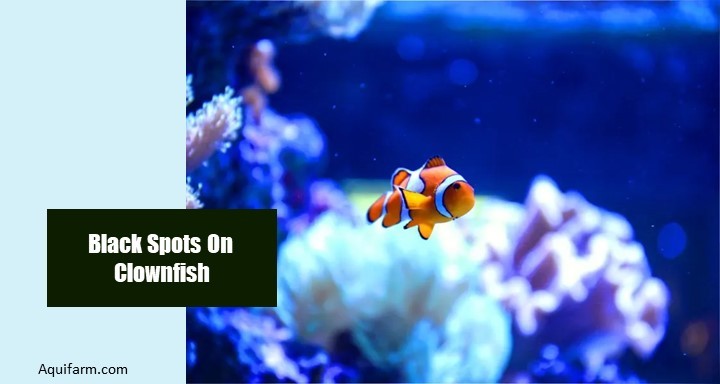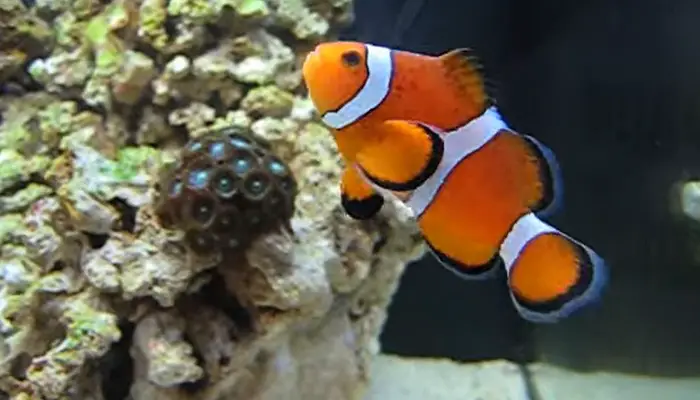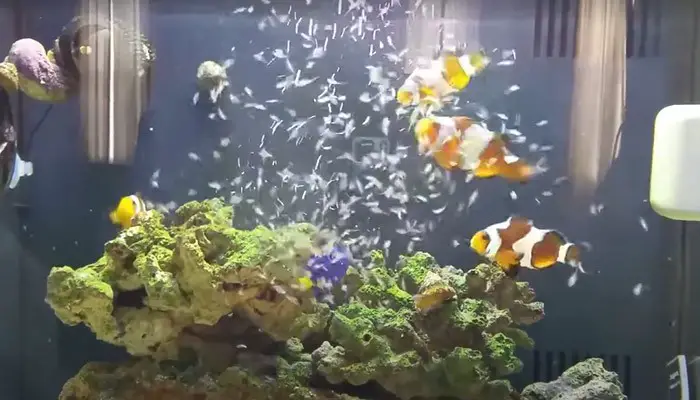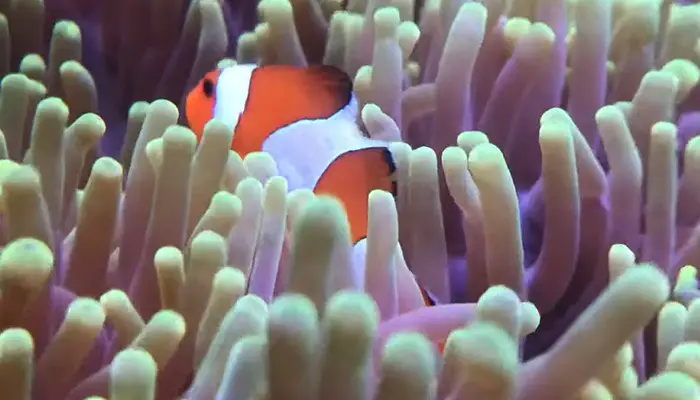
Do you still remember Marlin and Nemo from the movie “Finding Nemo”? We are telling you this because they are clownfish and who doesn’t like them?
However, that’s another story. But still, you may consider a clownfish as your first aquatic pet. It is because a clownfish is easy-going and hardy. Besides, they don’t need a large space to live happily.
Now, you must get anxious if you notice several black spots on the clownfish. You also may ask yourself- what should I do now? Are those black spots fatal?
But first and foremost, you need to know why you find black spots on clownfish. The primary reasons are- coral exposure, skin sensitivity, and fungal disease. After finding out the actual reason, you need to take action to remove the black spots.
This article will discuss the three causes behind black spots on your clownfish including their solutions.
So, let’s get this show on the road.
Why Does My Clownfish Have Black Spots?

We have gone through thorough research and found three primary reasons that cause black spots on clownfish. So, keep reading to learn about them and also their solvency.
1. Coral Exposure
Anemones and clownfish develop a mutual relationship in ocean life since both of them get benefits from it. That’s why the clownfish love to make their home for food and protection in the anemone’s tentacles.
Now, let’s get straight to the point. If a clownfish doesn’t find any anemone in the aquarium, it tries to build its home inside the coral. As a result, the coral stings the clownfish repeatedly which leaves black spots on its body.
However, the coral’s sting is not a fatal thing and it doesn’t change any behavior. Usually, it will go away over a few days naturally. But if you don’t like the black spots, then you can put your clownfish in a formalin bath.
Formalin Bath
The formalin bath is a very effective process for a clownfish. Besides, you can do it either in the fish tank or somewhere else.
To prepare a formalin bath for your clownfish, you need-
- A quarantine fish tank (if necessary); (our pick: Aqueon LED MiniBow Small Aquarium Fish Tank)
- 37% of formalin solution; (our pick: CH2O Pure Formalin Formaldehyde)
- Ammonia neutralizing product; (our pick: Aqueon Aquarium Ammonia Neutralizer)
- Antibiotics. (our pick: API Fin and Body Cure Freshwater Fish Powder Medication)
- Fresh saltwater;
- Two containers;
After collecting all the items, you need to follow the instructions below-
#Take A Quarantine Tank
Firstly, take a good quality quarantine tank for your fish. Make sure that it has enough space for fee-swimming and specific gravity. Typically, the gravity has to be about 1.010.
#Prepare The Container
First of all, you need to take one container. Then, pour the container with a 37% formalin bath solution. But, you must read the manufacturer’s instructions while preparing it.
In addition, place an air stone in the treated water. It’s because formalin always reduces the oxygen level in the water. So, the air stone will maintain the oxygen level.
Secondly, take another container for dipping. You can also add some ammonia-neutralizing product to give your clownfish a quick freshwater dipping.
#Treatment
After arranging everything, you need to place your clownfish on the formalin container. Place them carefully so that they won’t get hurt.
After the formalin treatment, locate the affected fish in the water dip. But it has to be only for 30 seconds to 2 minutes. After that, bring your fish back to the quarantine tank.
2. Skin Sensitivity
Another reason for black or dark spots on clownfish can be the water in the aquarium. In other words, the aquarium water gets dirty due to overfeeding and animal waste. As a result, the clownfish gets black patches as a reaction.
Fresh water is crucial for any aquatic animal. Above all, a clownfish needs an environment with accurate oxygen and pH levels. However, waste food, dead plants, and other organic waste make the water polluted.
This pollution not only causes black spots on the fish’s skin but also itchiness. Thus it creates discomfort among the fish population. To get rid of this problem, freshwater dipping can be an amazing solution.
Freshwater Dipping Treatment
The freshwater dip treatment is one of the fastest ways to get rid of black spots and itchiness from your clownfish. For this treatment, you need-
- Air pump; (our pick: Tetra Whisper Easy to Use Air Pump for Aquariums)
- Air stone; (our pick: Pawfly Aquarium 1 Inch Air Stone)
- Ammonia neutralizing product; (our pick: Aqueon Aquarium Ammonia Neutralizer)
- Nitrofurazone based medication. (our pick: API Fin and Body Cure Freshwater Fish Powder Medication)
- A large plastic container;
- Filtered water;
After that, you need to take these actions-
- Firstly, take a clean plastic container and fill it with fresh water. Make sure that the water is filtered. Besides, you can also use fresh tap water. But you must dechlorinate it in this case.
- Secondly, fix the temperature and pH level of the water. You can use a water heater to raise the water temperature. (our pick: Orlushy Submersible Aquarium Heater)
- To eliminate ammonia and nitrates from the water, apply any ammonia-neutralizing product.
- Thirdly, add an air stone to the container to maintain the proper balance. Besides, attach it with an aquarium air pump.
- Finally, place the affected clownfish into the freshwater solution. The duration has to be three to four minutes.
Remember not to put them in the freshwater dip for a long time. Moreover, if any fish shows any sign of stress, immediately remove them from the container.
3. Black Spot Disease
Another strong reason behind black spots on your clownfish is the black spot disease or tang disease. This disease is an infection caused by a kind of parasite called Turbellaria flatworm.
So, the black spots that you see on your clownfish are these flatworms. Typically, these parasites take the clownfish as a host for their lifecycle.
The flatworms get a chance to grow their population in the aquarium due to filthy substrate, dead plants, and polluted aquarium water.
Besides the black spots, if you notice the symptoms given below, you can be sure that your clownfish suffers from the black spot disease-
- Lethargy;
- Discoloration;
- Scratching against the substrate or decoration;
- No appetite.
Luckily, the flatworms or black ich on clownfish are not fatal and they can go away with proper treatment. Moreover, there are options to treat your clownfish from this black spot disease.
- Firstly, you must quarantine the affected fish in another tank or large container.
- Eliminate the polluted water and add filtered water to the aquarium.
- Vacuum the aquarium substrate with a gravel cleaner. (our pick: Natural Rapport Aquarium Gravel Cleaner)
- Make a formalin bath according to the manufacturer’s instructions and bathe your clownfish for two or three minutes.
- After that, locate your fish in a freshwater dipping container for a few minutes.
If this treatment doesn’t work, you can use prazipro (our pick: Hikari Usa AHK73254 Prazipro for Aquarium). In other words, Praziquantel works as an amazing fish dewormer since it can remove flatworms, flukes, and tapeworms well.
How Can You Use Prazipro?
Read the instructions below to know how to use prazipro-
- You don’t need a separate container to treat your clownfish with prazipro. Instead, treat the whole aquarium with it.
- First of all, change the water with fresh tap water.
- Then, remove carbon from the water by regular filtration.
- After that, add one teaspoon of prazipro per twenty gallons of water. It has to be once a day for 5 to 7 days.
- Typically, this single treatment is sufficient to remove all the flatworms. If it doesn’t work, then wait for at least four days and apply it again according to the instructions.
- Once all the flatworms are removed, you can bring back carbon in the fish tank water.
How to Prevent Black Spots on Clownfish

Noticing any unnatural thing on your pet fish is always annoying. For example, you don’t want to see black spots on your ocellaris clownfish. Besides, if you are extra-cautious, you will try to prevent it before it ever happens.
So, now we will show you how you can prevent black spots on clownfish with some simple actions.
Change The Water Frequently
A frequent water change is crucial for your clownfish since its body is extremely sensitive. So, the primary responsibility to prevent dark spots on clownfish is to change the water more often and clean the aquarium regularly.
In addition, make sure that the temperature and pH level of the water is suitable for your clownfish. You can also add a filter with the aquarium to make your work easier.
Add An Anemone

A clownfish and an anemone flower are the best friends ever! The anemones are the flowering plants from the family Ranunculaceae and the clownfish make their home in the mouth of this plant.
So, naturally, when they cannot find any anemone, they choose coral to seek their residence. As a result, the coral stings the clownfish and they get black spots. So, keeping the anemone plant in the aquarium is always a great idea to prevent it.
Feed Your Fish Properly
Your clownfish may develop some dark patches on its skin due to the lack of nutrients. So, keeping your fish healthy is also important to prevent black spots. For this purpose, provide a balanced and healthy diet to your clownfish.
Frequently Asked Questions
Can My Clownfish Turn Black When Aged?
A clownfish is turning black when it gets older. Don’t worry about it since it is a natural process. It‘s because when it gets older, its body becomes darker and eventually turns black.
Can I Remove The Black Ich From My Clownfish?
You can remove the black ich by taking some straightforward actions. Typically, the copper-based medication works best against the black ich. But before starting the treatment, you must quarantine the affected fish.
How Can I Deworm My Clownfish?
The best way to deworm a clownfish is to use prazipro. This product can eliminate all kinds of worms including tapeworms, flukes, and flatworms. But follow the manufacturer’s instructions carefully while using it.
Conclusion
Although clownfish are easy-going aquatic animals, you need to take proper care of them. Moreover, keeping the fish tank clean and feeding the clownfish healthy will prevent illness including black spots.
However, if you still notice black spots on clownfish, then first of all you need to know the actual cause behind it and take action instantly.
To sum up, we hope that you find the real cause behind the dark spots on your clownfish, including the solution from this article.
- Top 15 Freshwater Aquarium Plant Ideas for a Lush, Green Tank - November 9, 2024
- Top 13 Freshwater Aquarium Layout Ideas for a Beautifully Organized Tank - November 9, 2024
- 14 Stunning Rustic Freshwater Aquarium Ideas for a Tranquil Environment - November 9, 2024
